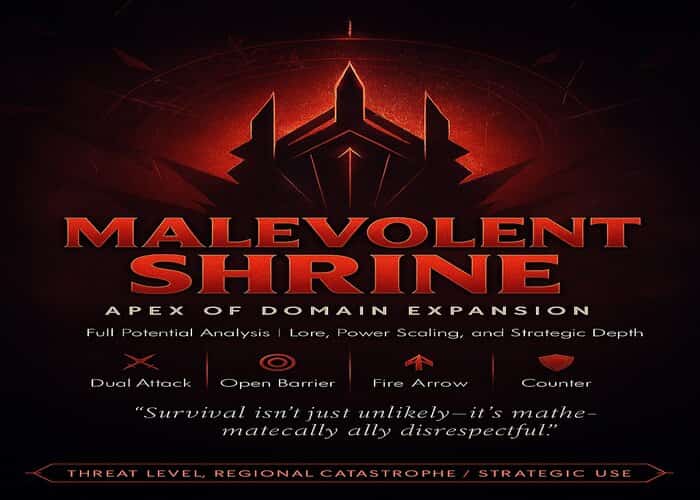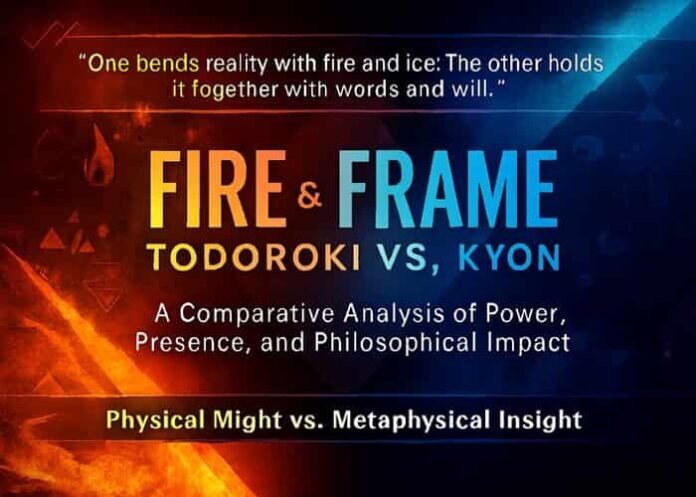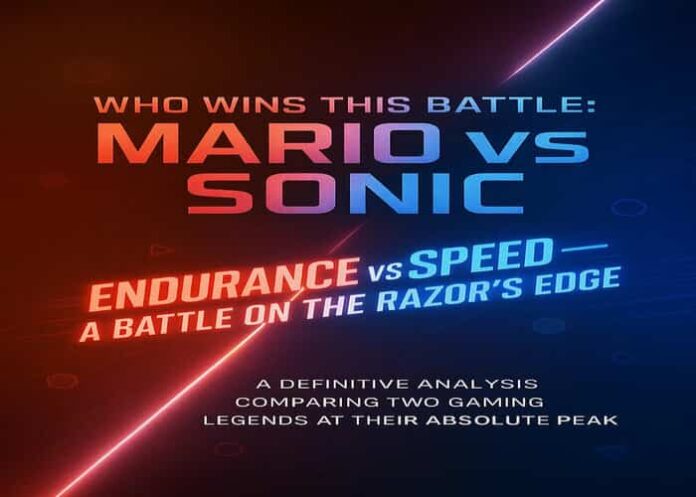
This analysis dives into Sukuna’s Malevolent Shrine from Jujutsu Kaisen, carefully separating what is confirmed in canon, what can be reasonably inferred, and what drifts into speculation. It’s part power breakdown, part lore exploration, and part cautionary tale of why you never want to be within 200 meters of this guy.
Established Canon Abilities
Domain Expansion: Malevolent Shrine (Fukuma Mizushi)
Sure-Hit Effect: Malevolent Shrine guarantees its attacks connect within range. This is the heart of every Domain Expansion. That doesn’t mean opponents are helplessskilled sorcerers can counter with defensive Domains, Simple Domains, Domain Amplification, or anti-domain tricks like Falling Blossom Emotion.
Dual-Natured Attack System
Dismantle (Kaitai): Perfect for slicing inanimate objects or targets with weak cursed energy (Manga Chapter 119).
Cleave (Hōryū): Automatically adjusts cutting strength and angle based on the enemy’s cursed energy, making it terrifyingly efficient against sorcerers (Manga Chapter 119).
Open-Barrier Domain Structure: Unlike typical Domains that trap enemies inside a closed space, Malevolent Shrine unfolds directly into the environment. This can be seen as a Binding VowSukuna gives up guaranteed containment but gains absurd range and sustainability.
Key Advantages
Range Like No Other: Demonstrated radius of about 200 meters, which means a 400-meter wide destruction zone. That’s city-block level control.
Energy Efficiency: Open-barrier domains appear to consume less cursed energy, a reasonable inference based on barrier mechanics rather than confirmed canon.
Escape is Possible, in Theory: No walls mean opponents could run. In practice? Not really. You’d need to be Usain Bolt with cursed energy steroids.
Selective Targeting: Sukuna can choose who gets sliced and who doesn’t. During Shibuya, he killed crowds but spared Megumi, proving precision within chaos (Manga Chapter 119).
The Shrine as Anchor: The structure that appears isn’t the source of damageit’s symbolic, acting like an anchor for Sukuna’s cursed energy and technique coordination.
Reasonable Inferences and Unexplored Element
Binding Vow Logic: Sukuna’s open-barrier design reflects deliberate trade-offshe swapped containment for massive range and efficiency. It’s the mark of someone who has mastered technique optimization.
Peak Refinement: Malevolent Shrine isn’t just powerfulit’s the most refined version of a Domain Expansion. This suggests Sukuna perfected it during his prime in the Heian Era.
Historical Weight: Being a Heian technique makes it a direct product of the golden age of jujutsu, combining ancient knowledge with terrifying skill.
Symbolism: The shrine’s imagery ties to Sukuna’s identity as the King of Curses. It might carry spiritual or thematic significance beyond combat.
Speculative Capabilities (Unconfirmed)
Fire Arrow (Fuga) Integration: Sukuna has Fire Arrow as a separate move, but there’s no evidence he can weave it into Malevolent Shrine’s sure-hit mechanic. The idea sounds plausible, but it remains unconfirmed.
Hidden Techniques: If Fire Arrow is considered a side move, Sukuna might be holding back other abilities. Whether they could expand the Shrine’s arsenal is anyone’s guess.
Bigger Spectacle?: Some fans imagine even more dramatic destruction if Sukuna went all-out. It’s fun to picture, but no manga proof exists yet.
Current Limitations and Strategic Constraints
Narrative Balance: If Sukuna spammed this at full power every fight, Jujutsu Kaisen would be five chapters long. Story pacing demands restraint.
Psychological Games: Sukuna enjoys tormenting enemies. He often holds back to savor the kill rather than instantly wiping the board.
Strategic Play and Host Body Issues: Early on, Yuji’s body restricted Sukuna’s full output, which shaped his strategic choices. Now, with more of his true form active, those biological limits fade, and strategynot physiologybecomes the real limiter.
Established Counter-Strategies
Effective Counters
Unlimited Void: Gojo’s Domain outclasses Malevolent Shrine and can nullify its effects.
Simple Domains: Offer small windows of survival.
Domain Amplification: Cancels techniques temporarily within its reach.
Falling Blossom Emotion: In theory, can defend against Domains. But its performance against Malevolent Shrine specifically remains untested.
Evolving Counters: As more sorcerers study Sukuna’s Domain, new countermeasures may emerge. Adaptation is inevitable.
Power Scaling Within Universe
Top-Tier Sorcery: Malevolent Shrine secures Sukuna’s place at the very peak of cursed technique mastery, rivaling or even outdoing Gojo depending on circumstances.
Regional Threat Level: At full output, the ability could wipe out districts. That’s disaster-class destruction.
Supreme Battlefield Control: The Shrine forces opponents onto the defensive. Few can challenge it head-on without their own Domain mastery.
Lore and Technical Connections
Barrier Heritage: Malevolent Shrine shows mastery of barrier principles, loosely echoing techniques like the Zenin clan’s Ten Shadows in terms of system-level sophistication.
Cursed Energy Pinnacle: This technique is the ultimate product of centuries of refinement in cursed energy use, polished during the Heian era’s peak.
Modern Benchmark: Today’s sorcerers measure themselves against Sukuna’s Shrine. It defines what “top-level” means in the current age.
Comprehensive Assessment
Malevolent Shrine is both an apex weapon and a reflection of Sukuna’s identity. Its designopen, efficient, surgicalshows not just raw might but flawless mastery. It doesn’t need speculative upgrades to cement Sukuna as one of the most dangerous entities in Jujutsu Kaisen.
When Sukuna fully unleashes this ability, survival becomes nearly impossible. The scale of its impact is nothing short of catastrophic, while the precision he wields makes it just as terrifying on an individual level as it is on a city-wide one.
Final Classification
- Threat Level: Regional Catastrophe with Surgical Precision
- Technical Rank: Apex of Domain Expansion Refinement
- Strategic Use: Dominant Control with Flexible Application
- Canonical Standing: Firmly established as a supreme-class cursed technique
Key Points
- Malevolent Shrine is not your average Domain Expansion. It’s an Open-Barrier Domain, no closed walls, trading containment for a massive 200-meter radius of destruction. Imagine a neighborhood watch, but the watch is slicing everything.
- Its attacks have a sure-hit property. Once you’re in range, it’s connect time. Still, defensive techniques can stall or block some damage if you’re skilled enough.
- The Domain uses two slicing moves: Dismantle for objects and weak targets, Cleave for cursed energy users. Think of it as Sukuna’s “cutlery set,” always sharp, always adjusting.
- Sukuna can choose who gets cut. Sparing Megumi during Shibuya wasn’t the Domain being nice, it was Sukuna being calculating. He plays chess while others play checkers.
- The shrine’s creepy design with skulls and grotesque features is more thematic than technical. It screams “King of Curses,” but don’t mistake it for a mechanical part of the attack.
- Malevolent Shrine is considered peak Domain Expansion refinement. Likely polished to perfection in the Heian Era, when jujutsu sorcery was at its prime.
- Fire Arrow is a separate move. Whether Sukuna can blend it into Malevolent Shrine isn’t confirmed, but the thought alone is enough to make sorcerers sweat.
- Early on, Yuji’s body capped Sukuna’s full output. Now with his real form returning, biological limits are fading. Strategy and twisted personality are the main brakes.
- Gojo’s Unlimited Void is one of the few Domains on a similar level. But it’s not a simple “one beats the other.” Context, timing, and execution matter.
- Malevolent Shrine is a walking disaster zone. Regional-level destruction with surgical precision, forcing anyone nearby into desperate defense.
Fun Facts
- The name and design reference Shinto shrines, giving Sukuna a mockery of sacred power.
- A 200-meter radius is basically two football fields long. If you thought PE class was tough, try running that under fire.
- Sukuna sparing Megumi was strategic, not sentimental. Cold calculation at its finest.
- The Heian Era was a real cultural golden age in Japan, fitting for Sukuna’s cursed peak.
- The shrine’s horror look with skulls and mouths isn’t canonically three-faced like some fan art. That’s fan flavor.
- “Fuga” as a name carries explosive vibes but isn’t a standard Japanese word for air displacement.
- Think of the sure-hit property as homing missiles in a circle. Missiles you can barely block.
- Sukuna’s sadistic flair makes him fit right into the trickster or chaos archetypes in mythology.
- Open-barrier Domains act more like cursed energy control zones than cages. You’re free to run, but not free to live.
- Selective targeting feels like smart weapon systems, except the programmer is Sukuna.
- The full 400-meter diameter is like four Olympic swimming pools in a row. Except no lifeguard on duty.
- A 200-meter radius is basically two city blocks. You’re not getting out unless you’re flash-fast.
- Sure-hit but blockable is like modern defense systems: coverage matters, but you’re not untouchable.
- Malevolent Shrine vs Unlimited Void plays out like mythic gods dueling in storytelling traditions.
- The slicing is metaphorically katana-like, fast and unseen until it lands.
- Fan art sometimes paints the shrine like Noh masks, symbolizing personas, but that’s fanon, not canon.
- The title King of Curses echoes monarch figures in global folklore who embodied fear and chaos.
- The cursed energy system mirrors East Asian ideas of ki or chi, giving the magic a familiar cultural root.
- Controlling whole areas like Sukuna does recalls scorched-earth strategies from real war history.
- And yes, fan commentary about the Shrine being like “living inside a blender” sticks, because it’s hilariously accurate.
Comedy Corner: If You Were Caught in Sukuna’s Malevolent Shrine
Of course, if you’re unfortunate enough to experience this technique firsthand, the scene might play out a little differently,
You tell yourself “it’s just a paper cut” as your house falls neatly in half.
Forget Uber Eatsyour food just arrives pre-sliced. The sushi chef is jealous.
You try to run but realize 200 meters is a lot farther when someone is trying to julienne you.
You proudly bring your Simple Domain, but it feels like using an umbrella in a hurricane.
Megumi gets spared and you don’tawkward.
You finally bought property in Tokyo, only for your neighborhood to become Sukuna’s cutting board.
Someone asks what Malevolent Shrine feels like, and you say “Imagine living inside a blender, but the blender hates you personally.”

